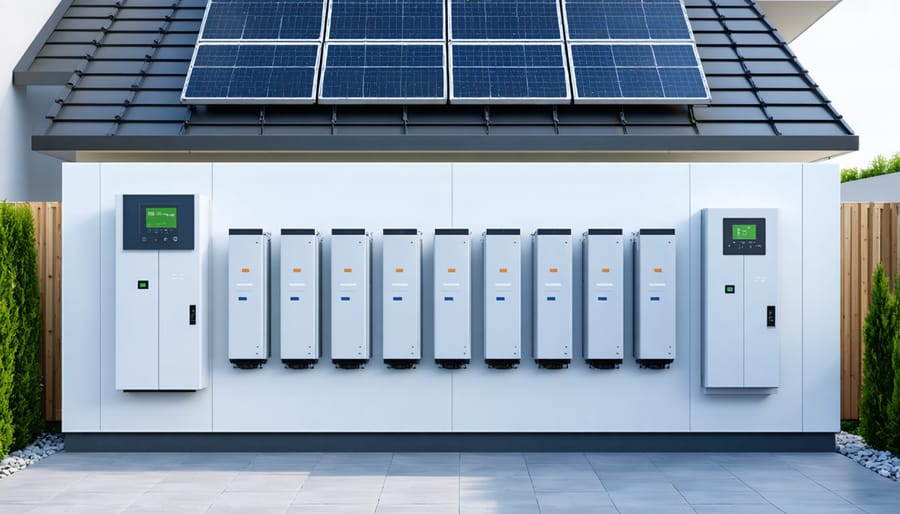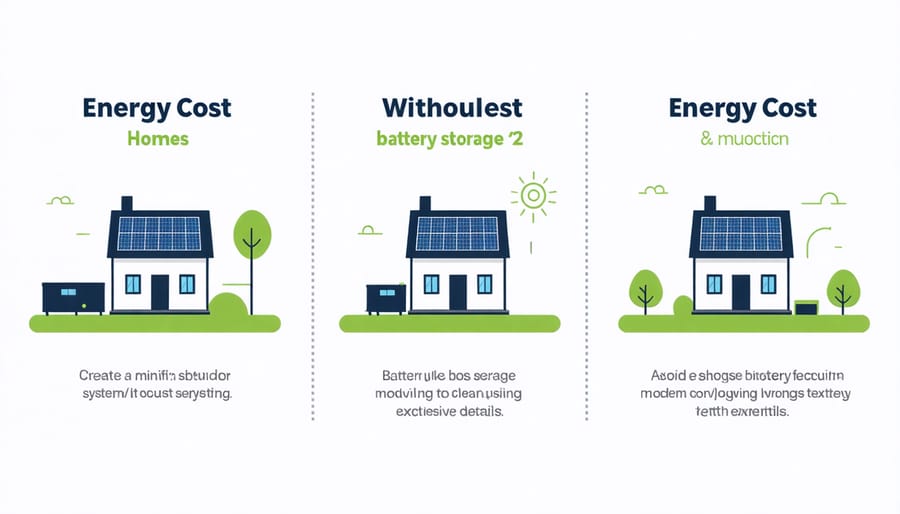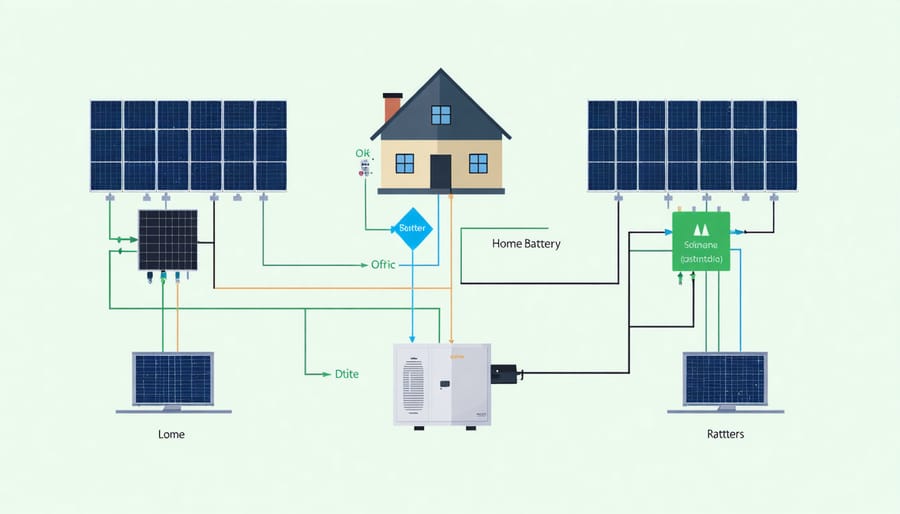Battery energy storage systems represent a game-changing technology that can transform your home’s energy efficiency and provide critical power backup during outages. As electricity costs continue to rise and grid reliability becomes increasingly uncertain, homeowners are turning to these sophisticated systems as a practical solution for energy independence. Whether paired with solar panels or operating independently, battery storage offers compelling advantages in terms of energy management and cost savings – but also comes with important considerations that every homeowner should understand before investing.
This comprehensive guide examines the real-world benefits and limitations of residential battery storage systems, helping you make an informed decision about whether this technology aligns with your energy needs and budget. From significant utility bill reductions to potential installation challenges, we’ll explore the practical implications of adding battery storage to your home, providing clear, actionable insights based on current market data and homeowner experiences.

Key Benefits of Home Battery Storage Systems
Lower Energy Bills and Cost Savings
One of the most compelling advantages of battery energy storage systems is their potential for substantial energy cost savings. By storing excess power during off-peak hours when electricity rates are lower, you can use this stored energy during peak times when rates spike. This smart energy management typically results in a 30-40% reduction in monthly utility bills for most households.
The financial benefits become even more apparent when paired with solar panels. Instead of sending excess solar energy back to the grid, you can store it for later use, maximizing your investment in renewable energy. Many homeowners report breaking even on their battery storage investment within 5-7 years, depending on local energy rates and usage patterns.
Additionally, some utility companies offer rebates and incentives for installing battery storage systems, further improving your return on investment. During power outages, these systems can also prevent costly food spoilage and potential damage to sensitive electronics, adding another layer of financial protection to your home.

Reliable Backup Power Supply
One of the most compelling advantages of battery energy storage systems is their ability to serve as reliable backup power solutions during outages. When the grid goes down, your battery system kicks in automatically, keeping essential appliances and systems running without interruption. This means your lights stay on, your refrigerator keeps food fresh, and your home security system remains active.
Think of it as having your own personal power station right at home. During blackouts, while your neighbors might be scrambling for flashlights, your home can maintain normal operations for hours or even days, depending on your system’s capacity and energy usage.
What’s particularly reassuring is that these systems are becoming increasingly sophisticated. Many modern batteries can intelligently prioritize power distribution, ensuring critical devices get electricity first. You can even customize which appliances and circuits receive backup power, giving you complete control over your emergency energy management.
For those working from home or with medical equipment, this reliability isn’t just convenient – it’s essential. Plus, the peace of mind knowing you’re prepared for unexpected power outages is invaluable, especially in areas prone to severe weather or unreliable grid service.
Smart Energy Management
One of the most exciting features of battery energy storage systems is their ability to make your home’s energy usage smarter and more efficient. These systems can automatically detect when electricity rates are lowest (typically during off-peak hours) and charge up, saving that power for when rates are highest during peak demand periods. This clever peak shifting capability can significantly reduce your monthly energy bills.
Think of it as having your own personal energy manager that’s working 24/7 to optimize your power usage. When demand on the grid is high during hot summer afternoons or cold winter evenings, your system can switch to battery power instead of drawing expensive electricity from the grid. Some advanced systems even learn your household’s energy patterns over time, automatically adjusting to maximize savings.
Many modern battery systems come with smart apps that let you monitor and control your energy usage right from your phone. You can track real-time power consumption, set charging schedules, and even receive alerts about potential savings opportunities. This level of control and visibility helps you make informed decisions about when to use major appliances or charge electric vehicles for maximum cost efficiency.
Potential Drawbacks to Consider
Initial Investment Costs
When considering a battery energy storage system, the initial investment costs can be substantial, but it’s important to understand what you’re paying for. A typical residential system can range from $8,000 to $20,000, depending on your storage capacity needs and system complexity. This cost includes the battery unit itself, inverter equipment, installation materials, and professional labor.
The battery unit typically accounts for about 60% of the total cost, while installation and additional components make up the remainder. If you’re adding storage to an existing solar setup, you might save some costs on installation and equipment sharing. However, if you’re starting from scratch, you’ll need to factor in a complete system setup.
Keep in mind that prices vary significantly based on your location, local labor rates, and permit requirements. Some areas require special certifications or additional safety features that can increase costs. The good news? Many regions offer tax incentives, rebates, and energy programs that can help offset these initial expenses. It’s worth checking with your local utility company and government offices to learn about available financial incentives before making your investment.
Space Requirements and Installation Considerations
When planning a battery energy storage system, you’ll need to carefully consider your available space. Most residential systems require a dedicated area roughly the size of a standard water heater – about 4-6 square feet of floor space and 4-5 feet in height. For optimal performance and safety, the installation location should be clean, dry, and temperature-controlled, typically ranging between 50-85°F.
Your garage or utility room often makes an ideal spot, but keep in mind that ventilation is crucial. The system needs adequate airflow to prevent overheating, and some installations may require additional cooling solutions. You’ll also want to ensure easy access for maintenance and emergency situations.
Installation considerations go beyond just space. You’ll need to account for the weight of the system (typically 200-500 pounds), so floor reinforcement might be necessary. Proximity to your electrical panel is another key factor, as longer cable runs can increase installation costs and reduce system efficiency. Local building codes may also dictate specific placement requirements, particularly regarding fire safety and emergency access.
Maintenance and Lifespan Issues
Like any home system, battery storage requires regular attention to keep it running smoothly. Most modern systems need minimal maintenance, typically just annual inspections by a qualified technician to check connections, clean components, and verify system performance.
The lifespan of your battery system largely depends on how you use it and the type of batteries installed. Most lithium-ion batteries, which are commonly used today, last between 10-15 years before their capacity noticeably decreases. During this time, you can expect a gradual reduction in storage capacity, usually around 2-3% per year.
To maximize your battery’s lifespan, avoid frequently depleting it completely and protect it from extreme temperatures. Many systems come with smart features that help manage charging cycles and prevent overuse. While replacement costs can be significant, proper maintenance and careful use can help extend your battery’s life well beyond the warranty period.
Keep in mind that technology is constantly improving, and newer batteries are becoming more durable and efficient. When planning your investment, factor in potential replacement costs after the first decade of use.
Making the Right Choice for Your Home
Assessing Your Energy Needs
Before diving into a battery storage system, it’s crucial to understand exactly how much power your home needs. Start by gathering your past 12 months of electricity bills – this will give you a clear picture of your energy consumption patterns and peak usage times.
Create a simple energy audit by listing all your essential appliances and their power ratings (usually found on a label or in the manual). Pay special attention to devices that use the most electricity, like air conditioners, electric heaters, and water heaters. Don’t forget about smaller items that run continuously, such as refrigerators and security systems.
Consider your daily routine: When do you use the most electricity? Are there specific times when multiple high-power devices run simultaneously? This information helps determine the right battery capacity for your needs.
Here’s a quick way to estimate your basic needs:
– Add up the wattage of essential appliances
– Calculate how many hours these run daily
– Factor in a 20% buffer for unexpected usage
– Consider future needs (like electric vehicle charging)
Remember that seasonal changes affect energy consumption significantly. Summer cooling and winter heating can dramatically increase your power needs, so account for these peaks when sizing your system. It’s better to slightly overestimate than underestimate your requirements, as expanding the system later can be more costly.
Comparing Different Battery Types
When it comes to storing energy at home, there are several different battery technologies to choose from, each with its own set of characteristics. Let’s break down the most common options you’ll encounter.
Lithium-ion batteries are currently the most popular choice for home energy storage. They’re compact, efficient, and have a long lifespan of 10-15 years. While they come with a higher upfront cost, their reliability and performance often justify the investment for many homeowners.
Lead-acid batteries are the traditional option and typically more budget-friendly. Though they’re bulkier and have a shorter lifespan (5-10 years), they’re well-understood and easily recyclable. They’re a practical choice if you’re working with a tighter budget and have ample installation space.
Saltwater batteries are emerging as an eco-friendly alternative. They’re non-toxic, extremely safe, and have a decent lifespan of 10-15 years. While they’re larger than lithium-ion batteries, they’re an excellent choice if environmental impact is your top priority.
Flow batteries are newer to the residential market but offer unique advantages. They can be fully discharged without damage and have a potentially infinite lifespan. However, they require more space and maintenance than other options.
When choosing your battery type, consider these key factors:
– Available space in your home
– Initial budget and long-term costs
– Expected system lifespan
– Environmental concerns
– Maintenance requirements
– Local climate conditions
Remember that the best choice will depend on your specific needs and circumstances. It’s worth consulting with a local energy expert who can assess your situation and recommend the most suitable option for your home.

Working with Professional Installers
When it comes to installing a battery energy storage system, working with qualified professionals is crucial for safety and optimal performance. Start by seeking installers certified by recognized organizations and those with specific experience in battery storage installations. Look for contractors who have completed manufacturer-specific training programs for the system you’re considering.
Always get multiple quotes and ask for detailed references from previous clients. A good installer should be willing to show you their portfolio of completed projects and share customer testimonials. During consultations, pay attention to how well they explain technical concepts and whether they take time to understand your specific energy needs.
Before signing any contracts, ensure the installer provides a comprehensive site assessment, including structural evaluations and electrical system compatibility checks. They should also help with necessary permits and utility company requirements. The proposal should clearly outline the installation timeline, warranty terms, and maintenance requirements.
Don’t hesitate to ask about their emergency response protocols and after-installation support. A reputable installer will offer ongoing maintenance services and be readily available to address any concerns. Make sure they provide detailed documentation of the installation and proper training on how to monitor and operate your system.
Remember, while cost is important, choosing an installer based solely on price might lead to problems down the line. Focus on finding a balance between experience, reputation, and value for money.
As we’ve explored throughout this guide, battery energy storage systems offer compelling advantages for homeowners looking to take control of their energy future. From reducing electricity bills and providing backup power during outages to supporting renewable energy integration and decreasing carbon footprints, these systems can be valuable investments for the right situations.
However, it’s essential to carefully weigh the considerable upfront costs, installation requirements, and maintenance needs against your specific circumstances. Not every home will benefit equally from battery storage, and your decision should be based on factors like your local electricity rates, power reliability, and renewable energy goals.
Before making your decision, we recommend:
– Getting multiple quotes from certified installers
– Checking local regulations and incentives
– Calculating your potential return on investment
– Assessing your home’s power needs
– Considering your long-term energy goals
For most homeowners, the best approach is to start with an energy audit and consultation with qualified professionals. They can help determine if a battery storage system aligns with your needs and budget. While the technology continues to improve and costs decrease, taking time to make an informed decision will ensure you get the most value from your investment.
Remember, there’s no one-size-fits-all solution, but with careful planning and consideration, you can determine if a battery storage system is right for your home.
